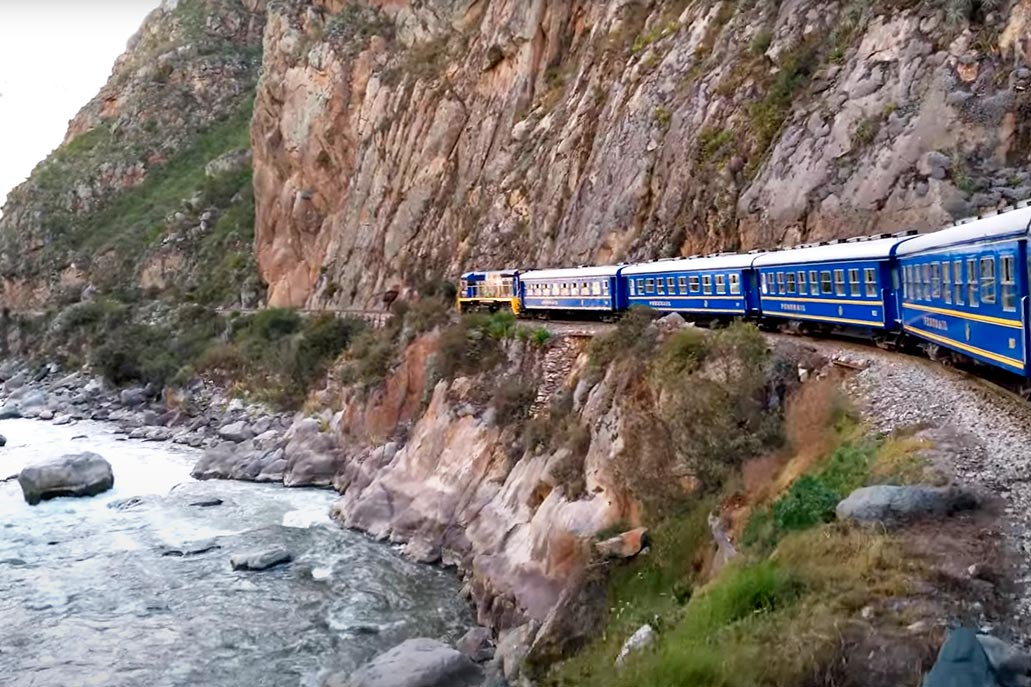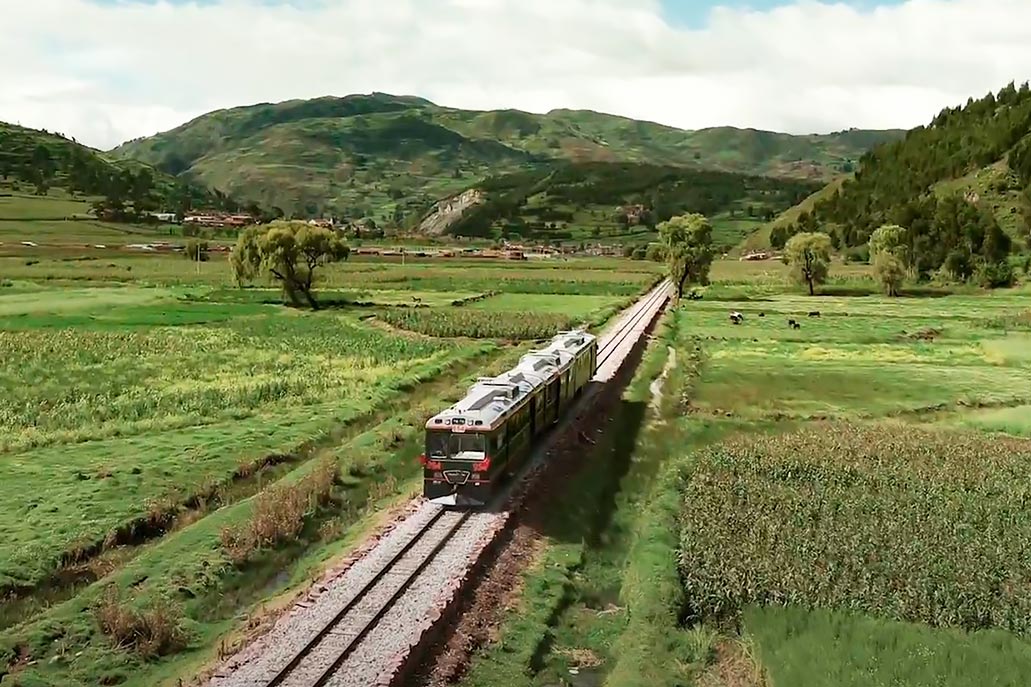Price of trains to Machu Picchu
The three is the main means of transportation to get to Machu Picchu. The trip begins in the city of Cusco, in the heart of the Andes Mountains in Peru. Through a bus trip you must arrive at one of the train stations (the most used is Ollantaytambo). There you board the train that, in 1 hour 30 minutes, will transfer you to the town of Aguas Calientes. This famous town is only 10 kilometers from Machu Picchu. There are different types of train services. Know their prices and main characteristics.

Contenido
The train trip to Machu Picchu
Don’t know how to get to Machu Picchu? Know that most tourists do it by train. The train trip to Machu Picchu begins in the city of Cusco. The capital of the Inca empire has 1 train station. The others are in the towns of Poroy (15 kilometers from Cusco), Urubamba (53 kilometers) and Ollantaytambo (61 kilometers). The latter is the most used by tourists as it has more daily train departures.
To get to Ollantaytambo station it is necessary to take public transport in Cusco. The train journey ends in the town of Aguas Calientes (approximately 30-kilometer route). The only way to do this trip is by train (there are no roads). After the train journey, you must take a bus from Aguas Calientes to Machu Picchu (10 kilometers away). In total, the trip (from Cusco to Machu Picchu) takes 4 hours on average.
Train stations
These are the stations enabled to take the train to Machu Picchu:
- San Pedro Station – It is located in the same city of Cusco (in front of the famous San Pedro market). Approximately four daily train services depart from there. The trip to Aguas Calientes takes 4 hours on average. The address is: calle Cascaparo 154, Cusco.
- Poroy Station – It is located 15 kilometers from the city of Cusco. From there 5 train services depart approximately a day. The trip to Aguas Calientes takes 3 hours 30 minutes on average. The address is: Calle Roldan s / n, Poroy – Cusco.
- Urubamba Station – It is located 53 kilometers from the city of Cusco. Two train services depart from there every day. The trip to Aguas Calientes takes 2 hours 30 minutes on average. The address is: Avenida Ferrocarril s / n, Urubamba – Cusco.
- Ollantaytambo Station – It is located 61 kilometers from the city of Cusco. More than 25 daily train departures depart from there. The trip takes almost 2 hours. The address is: Avenida Ferrocarril s / n, Ollantaytambo – Cusco.
The end of all train trips is the Aguas Calientes station. This famous place is also known as Machu Picchu town due to its proximity to the wonder of the world (only 10 kilometers away). More than thirty trains depart from there to Ollantaytambo, Urubamba, Poroy and San Pedro stations.
Types of services
These are the different types of Peru Rail services:
- Local train – Service that is used daily by the inhabitants of the communities near Machu Picchu. It is also used by Peruvians. It is not a service available for foreign tourists.
- Expedition Train – Tourist service that has comfortable seats, large windows, on-board service as well as sale of snacks and drinks.
- Vistadome Train – Tourist service that has comfortable seats, panoramic windows, on-board service, courtesy snacks, courtesy drinks as well as a dance show and parade of garments made of alpaca (only in the stretch from Aguas Calientes to Cusco).
- Sacred Valley Train – Tourist service that has comfortable seats, panoramic windows, lunch (or gourmet dinner), bar car, observatory car and more. It usually departs from the Urubamba station.
- Hiram Bingham Train – Luxury tourist service that offers all the comforts as well as lunch (or gourmet dinner), bar car, courtesy champagne, observatory car, live music show, final bus to Machu Picchu, tour guide service and more.
These are the different types of Inca Rail services:
- Voyager Train – Tourist service that has comfortable seats, large windows and on-board service with sale of snacks and drinks.
- 360º Train – Tourist service characterized by its panoramic windows with a 360 degree design. Offers complimentary snacks and drinks. Likewise, there is sale of handicrafts on board.
- First Class Train – VIP service that has covered tables, panoramic windows, welcome cocktail, lunch (or gourmet dinner) and observatory car. It operates from April to October.
- The Private Train – Three luxury trains that operate for a group that operates at the request of the visitor to transport them with their family, friends, place or companions (capacity for 8 people). It has an open bar, lunch (or gourmet dinner), observatory car and more.

Peru Rail prices
These are the (approximate) prices of the different types of Peru Rail train services:
Peru Rail train prices | ||
|---|---|---|
| Type of train service | One way price | Round trip price |
| Local train for Peruvians | 10 S/. (3 USD) | 20 S/. (6 USD) |
| Expedition Train | 180 S/. (60 USD) | 360 S/. (120 USD) |
| Vistadome Train | 240 S/. (80 USD) | 480 S/. (160 USD) |
| Sacred Valley Train | 540 S/. (180 USD) | 1080 S/. (360 USD) |
| Hiram Bingham Train | 1440 S/. (480 USD) | 2880 S/. (960 USD) |
Inca Rail prices
These are the (approximate) prices of the different types of Inca Rail train services:
Inca Rail train prices | ||
|---|---|---|
| Type of train service | One way price | Round trip price |
| Voyager Train | 180 S/. (60 USD) | 360 S/. (120 USD) |
| 360º Train | 240 S/. (80 USD) | 480 S/. (160 USD) |
| First Class Train | 540 S/. (180 USD) | 1080 S/. (360 USD) |
| The Private Train | 1440 S/. (480 USD) | 2880 S/. (960 USD) |
How to buy tickets?
The sale of train tickets is carried out: a) in person at the authorized ticket offices in Cusco or b) online through the Peru Rail and Inca Rail web pages.
- The official website of Peru Rail is: www.perurail.com.
- The official website of Inca Rail is: www.incarail.com.
The authorized offices for the face-to-face purchase of Peru Rail are at:
- Malecón de la Reserva 610 (Larcomar Shopping Center in Miraflores – Lima).
- Calle Portal de Carnes 214 (just in front of the Plaza de Armas in Cusco).
- Avenida El Sol 409, Cusco.
- Avenida Pachacutec s / n, Wanchaq – Cusco).
- Calle Cascaparo s / n, Cusco (Wanchaq station).
Authorized offices for the in-person purchase of Inca Rail are at:
- Calle Portal de Carnes 105 (right in front of the Plaza de Armas in Cusco).
- Avenida El Sol 843, Cusco.
- Calle Cascaparo s / n, Cusco (Wanchaq station).
- Avenida Velasco Astete s / n (Cusco city airport).
More information
There is a station called ‘Hydroelectric’ because it is next to a hydroelectric plant. This station is only 10 kilometers from Aguas Calientes so many tourists walk instead of taking the few daily trains. The hike is easy (2 hours on foot on average) and full of beautiful scenery. The bad thing is that the station is 6 hours by bus from the city of Cusco. It is the longest but cheapest route to visit Machu Picchu.
The tours already include train and bus tickets and the entrance to Machu Picchu. If you are coming on your own you must buy these tickets yourself. The best way to do this is buying online. Tickets to Machu Picchu have an approximate price of 152 S /. Train ticket prices vary, depending on the type of service. It is recommended to make the purchase weeks or months in advance. So you can get availability and better prices.
In addition to the train trip or the long route through the ‘Hidroeléctrica’, the other way to get to Machu Picchu is through the famous Inca Trail. This 4-day route is an incredible walk until arriving at the wonder of the world through the ‘Puerta del Sol’ (this is how the Incas did). The downside is that this tour has an approximate cost of $ 400 to $ 500 per person.
By Machupicchu Terra – Last updated, August 28, 2023